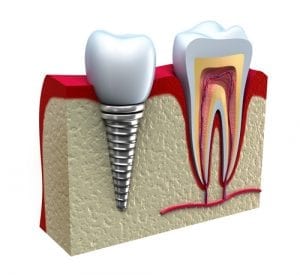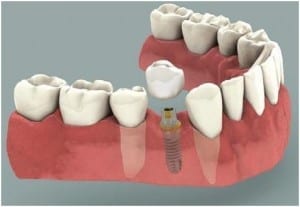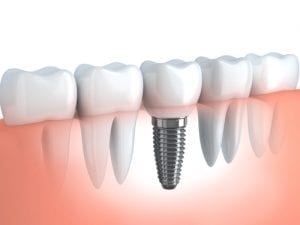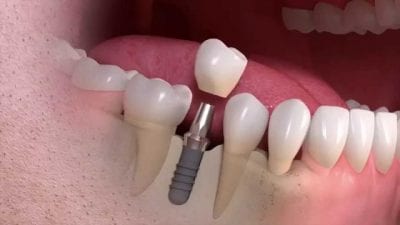If you’ve lost your tooth due to an accident, blunt-force trauma, or dental extraction (because it can’t be saved anymore through root canal therapy or it’s been cracked beyond salvaging), you can still complete your missing smile (and tooth) with dental implant surgery (otherwise known as a dental implant procedure).
What Is a Dental Implant?
Dental implant involves replacing an extracted tooth with a metal stud or post screwed right into the bone to serve as an anchor to the crown or false denture that would otherwise not have anything to keep it situated right into the tooth socket of your missing tooth. That’s the main appeal of a dental implant procedure.

The artificial teeth, denture, or crown, is plugged right atop the stud. Meanwhile, the post itself is what makes your new teeth look and function like real teeth. It’s the best alternative you have against bridgework that doesn’t fit too well or dentures that have a tendency to fall off (because they’re not permanently affixed to your gums and mouth anyway).
Implants are much more convincing as real teeth than detachable dentures or even crowns placed atop dental bridges that require the dentist to destroy two adjoining healthy teeth in order to place a false tooth or teeth between them and the gap of missing teeth, hanging over them like a bridge of sorts.
When Is This Used?
Implants, particularly the single-tooth variety, can be availed of by people who are missing one or more teeth. It’s usually availed of by those who’ve lost teeth and wish for a permanent teeth restoration solution that’s more dependable than dentures or a dental bridge. It’s also used in order to replace missing teeth with bone supports that have withered away due to periodontal disease.
- Extraction: If your withered or dead tooth hasn’t been extracted yet, it should be extracted in order to allow placement of your dental implant post. Naturally, you can put an implant where there’s still a tooth available. Then again, you also have the option to save the tooth with endodontic therapy or a root canal treatment.
- Preparation: From there, your jaw will be prepped for surgery. You might need to get bone augmentation through bone grafts as well to give the post enough bone and room to anchor itself to your jaw. Without enough bone to embed the implant upon, the implant will fail to stick.
- Surgical Insertion: The implant is surgically inserted into the tooth socket via an opening, your dentist himself will make within the jawbone. This involves cutting away the gum then drilling into the jawbone itself in order to place the stud or post into the bone via screwing it into place.
- Healthy Surrounding Teeth: The natural teeth and their supporting tissues near the tooth socket where the implant is supposed to be inserted must be in excellent health and not suffering from gingivitis or periodontitis. Otherwise, the dental implant procedure won’t succeed.
- New Tooth Root: After implant integration has taken place, with the post becoming one with your jaw bone, it will serve as your new tooth root for the crown that will be placed atop or plugged into the stud. An abutment is required to support the connection between crown and implant.
- The More Preferable Crown: The cap or crown is more preferable to the denture or a false set of teeth because it has a natural tooth look and it even feels like one of your teeth due to its dental implant anchor. The abutment that connects the crown to the implant also looks like a tooth, albeit smaller.
- Fills in Gaps and Restores Your Bite: Dental implants are also dependable because they fill in the gap left by the missing tooth. If you leave the gap alone and decide to not go through a dental implant procedure, your teeth will gradually move towards the gap to balance your bite out, thus changing your jaw shape and teeth placement.
- Stops Facial Structure Degradation: Implant dentistry can prevent your face, jawbone, and chin from changing down the line in order to accommodate the gap from your missing tooth. The more missing teeth you allow to remain missing, the more your bone, facial, and jaw structure will change as you grow older.
- Dental Implant Bridge: Even if it’s just a single-tooth stud type of implant, you can use it to replace a whole row of missing teeth by placing two studs on opposite ends of the row to create a bridge of sorts (as opposed to destroying existing teeth to serve as placements for a dental bridge).
Parts of an Implant

A tooth restored by implant dentistry is composed of the following parts.
- Implant: The titanium stud, post, or implant is placed on the lower or upper jawbone (wherever your missing tooth used to be, right into the socket). It’s the metal anchor that doubles as your restored tooth’s new tooth root of sorts.
This titanium implant is what gives crown false teeth or dentures that extra natural feeling when you wear them. This is in contrast to bridges that require you to destroy healthy adjoining teeth or dentures that can get dislodged rather easily.
- Abutment: This can be made of porcelain, surgical stainless steel, zirconia, gold, or titanium. It’s screwed into the implant and serves as the filler or an adapter that connects the crown to the implant. The substructure or connecting element adds extra support to the crown as a supporting contact.
This is the main adapter of your implant setup that connects the implant with the crown better. The abutment is necessary because it makes it harder for the crown to loosen up or crack under biting pressure compared to simply slapping the crown into the implant.
- Crown: The crown is the part of the restored tooth that looks and is shaped like a natural tooth. It serves as the cap that you put onto your implant in order to serve as your replacement tooth. It’s made to be tough and it’s actually replaceable in case it cracks.
The crown is typically made of PFM (a metal alloy) fused with porcelain so that you end up with a denture that’s arguably tougher than your average tooth. This crown is cemented or screwed onto the abutment. If screwed, the screw hole is covered with a restorative material used in filling cavities (composite).
The Implant Process
In regards to the implant process itself, here’s a step-by-step guide you can follow in order to properly go about this dental implant procedure.
Preparatory Precautions
You need to have your implant surgery approved before anything else. Here are the steps that you should expect to happen. In many ways, preparing for the implant takes longer than the dental implant procedure itself.
- Initial Consultation: You will first have to undergo a consultation with a prosthodontist before any work is done. This specialist (or a general dentist with special training in implant placement and restoration) will determine if you’re a qualified candidate for implant dentistry or not.
- Comprehensive Examination: Your dentist will have you undergo an exam where he’ll review your dental and medical history. He’ll also create impressions of your gums and teeth (for the sake of creating teeth models) plus take dental x-rays of your jaw, particularly the area where the missing tooth or teeth are.
- CT Scan of the Mouth: There are also cases wherein a computer tomography scan (also known as a CAT or CT scan) of your mouth is required so that the dentist knows what he has to work with. It assists him in determining how much jawbone is available for implantation or if bone grafts are called for (particularly those who lack a strong jaw or chin will need bone augmentation).
- Nerves and Sinuses: The CT scan also assists in locating structures such as sinuses and nerves that should be avoided while doing implant surgery. The last thing you want to happen is to suffer from nerve damage or break your sinuses while attempting to regain the tooth that you’ve lost through restorative means.
Bone Grafting
If there’s not enough bone in your jaw to hold an implant according to x-rays or the CT scan, the dentist can discuss options for bone augmentation or buildup.
As noted in the earlier sections, grafting might be called for in order to ensure there’s enough bone for the post to embed itself in. Otherwise, the dental implant procedure might fail and end up dislodging itself when you apply the regular biting forces of the human mandible unto your implant.
- What to Expect with Bone Grafting: When it comes to augmenting your jaw, it typically involves taking bone from other parts of your jaw/hip/chin, through a donor, or through artificial bone material (calcium phosphate or hydroxyapatite) and adding it to your jaw so that an implant can anchor itself deep into your mouth like a real tooth root. Processed pig, cow, or human cadaver bone can also be utilized.
- What to Expect with Bone Distraction: A bone distraction is different from a bone graft in that it’s a surgical procedure that induces the body to grow more bone at the site where it’s needed the most versus putting bone material there and fusing it with your jaw. It involves using pins and screws to pull apart existing bone, which causes your body to grow more bone to fill in the gaps.
If one of these procedures is needed before you can proceed to the actual dental implant procedure, it will probably take four to twelve months for the bone to be ready for grafting and implantation.
Traditional Method

The traditional method requires two procedures, with three to six months between each. The extra months are for the sake of allowing the patient to heal first.
- Initial Incision: In the first procedure, a small part of your gums are cut where the implant will be placed (the tooth socket that the gum is covering). The cut is necessary in order to gain access to the tooth socket where your missing teeth used to be.
- Cutting and Drilling: After the small gum incision has been made, your dentist will then drill right into the bone. This is for the sake of placing the metal implant or post itself into the hole in your bone. After implantation is complete, the incision on the gums is then stitched and then allowed to heal.
- Healing Period and Second Procedure: After three to six months of healing has taken place, you can then procedure with the second part of the traditional dental implant procedure. This involves making a new cut to expose the implant. From there, a healing cap or collar is screwed atop the stud.
- Healing Cap Removal: The healing cap is called as such because it’s designed to induce healing of the surrounding gum tissue. After a few weeks have passed, the healing cap is then taken off.
- Abutment and Crown Placement: The aforementioned abutment is now put into place for the sake of being the supportive element to the final crown. The abutment is necessary in order to ensure a tight fit for the crown that won’t easily get dislodged due to human biting forces.
One Stage Process
Patients who are impatient with the long-haul wait times of a traditional dental implant procedure can avail of one-stage implant dentistry instead. This is sometimes used for implants, but its availability depends on the clinic or the dentist doing the surgery.
During this procedure, your dentist will place the implant, abutment, and a temporary crown or bridge all in one visit. The healing of the gum will have to go through an already completed implant setup with no healing caps involved.
On the bright side, the dentist won’t have to do incisions and stitches over and over again over a three to six-month period. The again, this carries the risk of complications since traditional implants allow your body to better acclimate itself with the placement of the implant compared to a one-step dental implant procedure.
Thantakit International Dental Center is Thailand’s longest established dental center. Situated in Bangkok, our clinic is renowned across the world as a destination for world-class dentistry, with most of our patients flying to us from Australia.
Please contact us today and get a FREE dental consultation.












